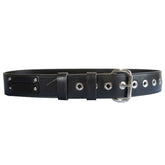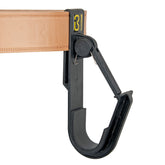As someone once said, “Working safely may get old, but so do those who practice it.”
It was [1]1992 when the U.K. introduced the Personal Protective Equipment (PPE) Regulation (PPER), which placed a duty on every employer to provide PPE to employees whose health and safety could be at risk due to the manner of their job.
From nurses to tree surgeons, abrasive blasters to chemical engineers, PPE is incredibly essential.
What is Abrasive Blasting?
For those who don’t quite know, abrasive blasting (also known as sandblasting) uses pressurised air or water that is forcibly propelled against a surface under high pressure. This is done for several reasons, such as smoothing a rough surface or vice versa, removing contaminants or paint, preparing surfaces, or cleaning rust or grease.
What are the Risks?
Abrasive blasting is extremely dangerous, with the user facing several potential risks such as [2]lung damage, hearing loss, burns, sight loss, as well as other cuts and similar injuries if PPE is not worn, or used incorrectly.
Here are just a few examples of the risks that can be prevalent with the improper or nonexistent use of PPE during abrasive blasting.
- Abrasions are typically [3]common when gloves and coveralls are not worn. When pressurised air or water is ‘blasted’ against certain materials or surfaces, abrasive particles may come loose and come into contact with the operator.
- Explosive dust is a dangerous result of metal abrasives from the abrasive blast (or sandblast) machine, and a metal surface being cleaned. This explosive dust can cause serious eye injuries, from corneal abrasions to blindness.
- Abrasive Blasting (sandblasting) can be extremely loud. So, with long-term exposure to such sounds without the correct PPE (or with PPE not worn correctly), hearing impairments or even full deafness can occur.
- When it comes to PPE, it can be so easy to focus on the visual risks, that we may sometimes forget about the physical strain and long-term toll this can take on someone. The equipment used for abrasive blasting can be awfully heavy and very complex to use. Improper use, inadequate training, or even long-term operation, can lead to fatigue and muscle strain. Training and knowledge can sometimes be the only PPE needed in some circumstances.
While it may be given that employers will prioritise their employees’ safety by supplying the correct PPE or providing the necessary PPE training, it is the unfortunate reality that, sometimes, this isn’t the case.
The Results of When an Employer Lacks Responsibility
On [4]February 2023, an employer located in Nipawin, Canada, pleaded guilty and was charged with a severe safety violation that resulted in a worker suffering fatal injuries while using an abrasive blaster.
During an investigation, it became clear that the company had “failed to provide and maintain approved blasting hoods supplied with air that is clean and at a reasonable temperature for workers engaged in abrasive blasting, resulting in the death of a worker.”
The worker in question succumbed to injuries sustained as a result of carbon monoxide exposure while using an abrasive blaster.
The Dangers of Sandblasting
Sand can be commonly used in the process of abrasive blasting, hence the phrase, sandblasting or sandblasters. Blasting sand emits crystalline silica, a natural mineral that is also known as quartz.
This mineral is extremely hazardous if inhaled, causing serious damage to the lung tissues. Fibrotic nodules will develop and trap the silica particles, which will cause silicosis. This lung condition can develop later into other illnesses such as tuberculosis, COPD, and lung cancer. It is estimated that out of all blasting abrasives used, [5]63% of them are silica sand, which puts into perspective the dangers abrasive blasting contains.
Don’t become another Statistic
It’s easy to feel invincible, with all of us being guilty of thinking “Oh, it won’t happen to me” at some point. But the realisation is that if the dangers are possible, then the risks are even greater.
For things to be discovered or invented, it takes an incident or accident to push these innovative developments. This leaves the unfortunate reality that some people pay the price for such laws and regulations to be put into place, to avoid such disasters from happening again.
When PPE is worn and worn responsibly, it allows us to focus on the benefits and positives that such a process, like abrasive blasting, can bring, instead of the negatives.
Abrasive blasting is an efficient, time-saving process for [6]paint removal from a range of surfaces, including plastered walls. Renovating sandstone buildings by removing dirt and grime buildup and restoring them to their original condition. It’s a solution for [7]rapid rust removal, a greater paint adhesion by making smooth surfaces coarser, and surface decontamination. The list goes on.
Let’s remember, PPE was developed for a reason, so let’s take advantage!
Click here to view our Blasting Equipment.
[3] https://www.blockotoole.com/ny-construction-accidents/sandblasting/
[4] https://www.paintsquare.com/news/employer-fine-for-blaster-worker-death
[5] https://www.ncbi.nlm.nih.gov/books/NBK560061/
[6] The Benefits of Abrasive Blasting – Direct Blast
[7] The Many Benefits and Types of Abrasive Blasting | Alpine Painting





















